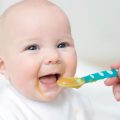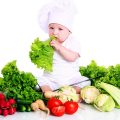When it comes to introducing your baby to new solid foods; nothing is more adorable for parents than seeing their baby happy with food all over his face, and everywhere else. This cute picture is something every parent will cherish in their lifetime. Indeed, introducing your baby to new solid foods is fun, but it’s no secret that it can be messy too. In this article, you’ll learn introducing your baby to new solid foods.
The AAP or American Academy of Pediatrics recommends parents to start their child on solids between four to six months. And within this time frame; parents should look for developments to determine whether their baby is ready for solid food, or not.
- Can sit straight and hold his head
- Mastered tongue movement
- Already curious about his surroundings
- Seems hungry even after a full-day portion of milk (about 8 to 10 breastfeeds or 32oz formula)
Should My Baby Still Drink His Breast Milk or Formula Milk?
Until when should parents continue with milk feedings? Well, experts suggest keeping milk for a while. Milk provides the important nutrients their body needs for development; and their tummy is used to them – they feel comforted by clinging on their mother and the taste of their milk.
Babies should be fed with their milk (whether breast milk or bottled milk) first thing in the morning; before or after every meal, and before bedtime. Parents will have to experiment to find what works best on their babies at the beginning. If the baby is already a big drinker (can finish a whole bottle before meal), then given the chance; they should eat solid food first before they can drink their milk. For moderate drinkers, parents can do the opposite.
They will still drink the majority of their calories even until 7 to 10 months. Mealtime should be about getting them used to the act of eating and learning how food tastes; and understand different textures on their mouth, while provide them with nutrients their body vitally needs for development.
Up to 9 months, they should still drink breast milk every 3 to 4 hours; or 20 to 28oz of formula a day.
At 10 to 12 months, they should breastfeed for every 4 to 5 hours; or feed 16 to 24oz of formula milk a day.
What the Feeding Schedule Should Look Like
Naturally, babies will be excited of their mealtime as soon as they understand the concept of eating solid. This usually takes place around 6 to 9 months.
Three Meals A-Day
Their routine should be about breakfast, lunch and dinner. This way, you will get your baby used to the idea of eating schedule; and eat even when they’re not hungry. The goal here is to get them on a big eating schedule by the time they turn 1-year old. Thus, three meals a day; with two snacks in between (finger foods like teething biscuits and baby crackers are the recommended snacks for babies).
Liquids, be it breast milk or formula milk; should be used as a complement to their meals, rather than meal itself.
- At four to six months, babies should eat two meals a day; with each meal consisting around two to four tablespoons.
- At seven to one-year; they should be eating three meals a day, with meal size about the size of their fist.






 I love to write books about family, dating, household, and healthy living. My books are written for everyone in an easy to read and understandable style.
I love to write books about family, dating, household, and healthy living. My books are written for everyone in an easy to read and understandable style.